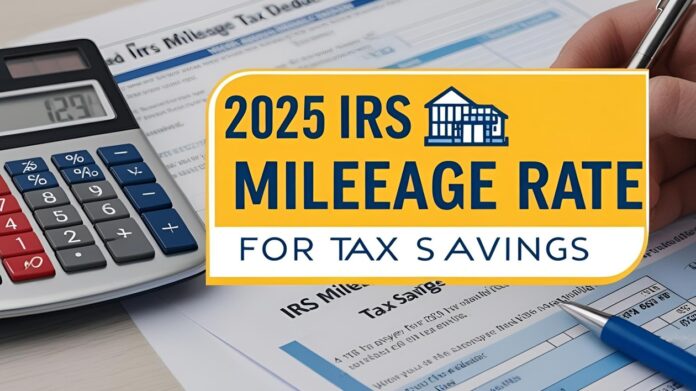Understanding the 2025 IRS Mileage Rate as a Freelancer
For freelancers, managing business expenses is essential for maximizing profit and reducing tax liability. One often-overlooked deduction is the mileage you rack up while driving for work. The 2025 IRS mileage rate allows you to deduct vehicle-related costs without needing to track every gas purchase or maintenance receipt—making it an ideal method for freelancers who work independently.
Whether you’re a freelance writer heading to a co-working space, a consultant driving to client meetings, or a photographer traveling to a shoot, miles you drive for your business can add up quickly. By applying the standard mileage rate, you can convert those miles into real tax savings.
What Is the IRS Mileage Rate for 2025?
Each year, the IRS updates the mileage rate based on trends in fuel prices, vehicle maintenance costs, depreciation, and insurance. While the finalized rate for 2025 will be announced near the end of 2024, early estimates project:
- 67 cents/mile for business driving
- 21 cents/mile for medical and moving travel (military only)
- 14 cents/mile for charitable driving
As a freelancer, you’ll primarily use the business mileage rate. This rate allows you to multiply the total number of work-related miles driven by the IRS-approved amount to calculate your deduction.
Why the IRS Mileage Rate Is Ideal for Freelancers
Freelancers often operate on tight budgets and lack access to traditional employer reimbursements or company-owned vehicles. That’s what makes the standard mileage rate so valuable—it offers a simple, legally sound way to reduce your taxable income without a complex paper trail.
It Simplifies Expense Tracking
Using the mileage rate saves you from tracking gas, oil, maintenance, insurance, and depreciation separately. Instead, you only need to track the miles you drive for business.
It Protects You in Case of an Audit
When you use the IRS standard rate and follow proper documentation practices, you’re using a method the IRS expects and recognizes. This minimizes red flags and audit risk.
Qualifying Business Trips for Freelancers
Not all driving qualifies for the deduction. Here’s what does:
- Driving to meet clients or collaborators
- Traveling to job sites or freelance gigs
- Driving to pick up supplies or deliver materials
- Attending networking events, conferences, or business-related training
- Trips to the post office to mail client packages or invoices
What Doesn’t Count
- Commuting from your home to your regular workspace (even if it’s a co-working space you visit daily)
- Personal errands or travel that’s only partially business-related (you can only deduct the business portion)
- Being disciplined about what qualifies ensures you claim the right deduction without risking errors.
How to Track Mileage Accurately
To use the standard mileage deduction, the IRS requires detailed, timely records. This means you can’t just estimate your annual mileage in April when filing your return.
You must record:
- The date of each trip
- The business purpose
- The starting point and destination
The number of miles driven
Best Mileage Tracking Tools for Freelancers
Manual logbooks and spreadsheets are acceptable but can be tedious and error-prone. Mobile apps like MileIQ, TripLog, Everlance, or Stride automatically detect when you’re driving, log the miles, and let you categorize trips as business or personal. These apps can export tax-ready reports at the end of the year, saving you time and reducing the chance of mistakes.
How Much Can You Save Using the 2025 Rate?
Let’s say you’re a freelance graphic designer who drives 10,000 miles per year for client meetings, printing services, and networking events.
- 10,000 miles × $0.67 = $6,700 deduction
If you’re in the 22% tax bracket, this deduction saves you $1,474 in federal income taxes. And that doesn’t even include state income tax savings or the reduction in self-employment tax.
Multiply this across several years, and the mileage deduction can become one of your most consistent and powerful tools for saving money.
Standard Mileage Rate vs. Actual Expenses
The IRS gives you a choice between two deduction methods:
1. Standard Mileage Rate
- Easier to calculate
- Requires tracking only miles
- Ideal for freelancers with fuel-efficient vehicles or limited car expenses
2. Actual Expenses Method
- You deduct gas, insurance, repairs, maintenance, and depreciation
- Requires detailed receipts and cost tracking
- Can result in higher deductions for expensive or older cars
Most freelancers benefit from the standard mileage rate because it simplifies filing and typically results in a competitive deduction. However, if you’ve spent a lot on vehicle upkeep or lease payments, it’s worth calculating both methods.
Important Note: If you use actual expenses the first year you place a vehicle into service for your business, you may not be allowed to switch to the standard mileage rate later.
How to Report the Deduction on Your Taxes
If you’re a freelancer filing taxes with Schedule C (Form 1040), you’ll report mileage under the “Expenses” section:
- Indicate whether you used the standard mileage rate
- Provide total miles driven for business
- Answer a few vehicle-use questions (e.g., Do you have another car? Was the car used for personal purposes too?
Using tax software like TurboTax, FreeTaxUSA, or working with a CPA will walk you through the steps easily.
Tips for Freelancers to Maximize Their Mileage Deduction
- Start tracking on January 1st and keep it going throughout the year
- Classify trips correctly—don’t mix personal errands with business trips unless you split the mileage
- Use one car consistently for business use to simplify documentation
- Review IRS mileage rate changes—the IRS may update the rate mid-year
- Back up your logs monthly in case your device is lost or damaged
Consistency and discipline are key. The more organized your mileage logs are, the easier tax time will be—and the more you’ll save.
Watch for Mid-Year Mileage Adjustments
In some years, the IRS issues a mid-year mileage rate change, especially during periods of inflation or rising gas prices. If this happens in 2025, you’ll need to track your business miles separately for each period:
- Miles driven before the rate change
- Miles driven after the rate change
Apply the appropriate rate to each set of miles when calculating your total deduction.
Conclusion
The 2025 IRS mileage rate is a powerful tool for freelancers who want to lower their tax bills without drowning in paperwork. It transforms ordinary driving into real tax savings and helps you get rewarded for the miles you log while growing your business.
To get the most from this deduction, track every qualifying trip, use a mileage app to automate logs, and start early. When tax season rolls around, you’ll be glad you did. Every mile counts—and for freelancers, those miles can mean hundreds or even thousands saved each year.





